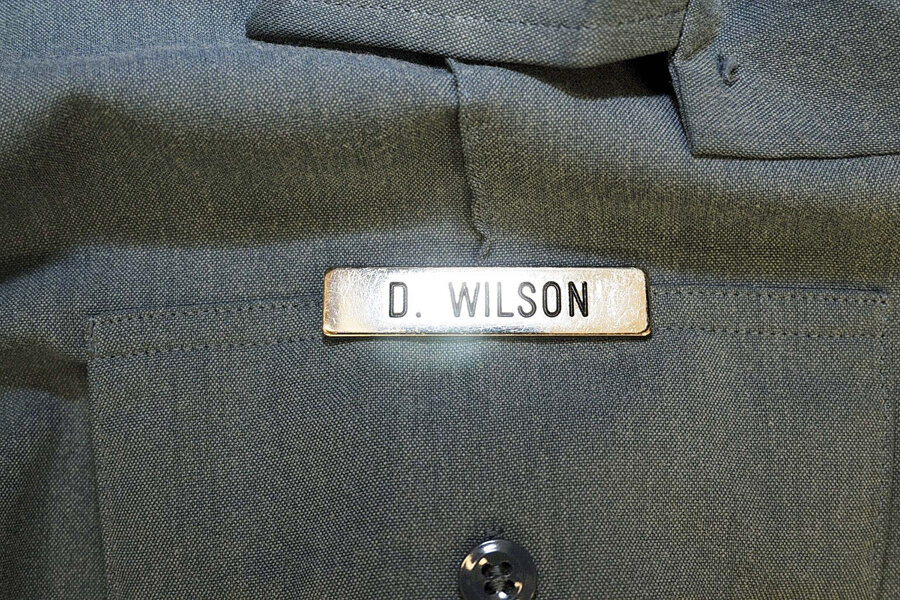Darren Wilson testimony raises fresh questions about racial perceptions
Loading...
The release of officer Darren Wilson’s grand jury testimony about his role in the death of Michael Brown has reopened questions about the degree to which white cops view black suspects through a potentially distorting lens.
Wilson’s testimony, released Monday after a grand jury decided not to indict him, offers an unusual and unvarnished look into the mind of a cop deciding whether to use deadly force in a situation that had spiraled out of control.
His comments to the grand jury paint a portrait of a man fearful for his life, and courts have repeatedly acknowledged the danger of police work by giving wide latitude to officers when life may hang in the balance.
Yet some of his characterizations of the incident have raised red flags among experts who study race and policing.
For example, Wilson describes Mr. Brown as looking like a rage-filled “demon” as he geared up to charge the officer. Wilson said that he felt like a kid trying to wrestle Hulk Hogan during their altercation, despite being roughly the same height as Brown. And he characterized Canfield Drive, where Brown was shot, as an area “hostile” to police, meaning his guard was already up when he approached Brown about a stolen box of cigarillos.
The broader question for policing is not necessarily one of overt racism, rather it is a question of whether unexamined perceptions of black people and black neighborhoods creep into the so-called use-of-force matrix an officer turns to in times of crisis. In a country where black people are up to 21 times more likely to be shot by police than whites, according to a ProPublica analysis of FBI statistics, the issue is of enormous importance, experts say.
“These are very much the issues at play: you do have to be careful about scrutinizing why people make certain judgments about people being threatening,” says Jens Ohlin, a professor at Cornell Law School in Ithaca, N.Y.
Studies are not conclusive. A 2010 article in the Southwestern Journal of Criminal Justice looked at 10 years’ worth of peer-reviewed studies on police use of force in minority neighborhoods. The authors found studies that established connections between an increased use of force and minority status, and others that found no correlation.
A 2003 study by William Terrill and Michael Reisig did conclude that police officers tend to use more dramatic force when dealing with suspects in poor, minority neighborhoods. When race, class, gender and age “are considered at the encounter level, they are significant," they write.
But the reason might not be racism, overt or subtle. It could be the simple fact that police are more on their guard in such neighborhoods. “Perhaps officers do not simply label minority suspects [as] ... ‘symbolic assailants’ as much as they label distressed ... neighborhoods as potential sources of conflict.”
The reasons for caution on the part of police are not imagined.
“Some research [shows] that even well-trained officers are not consistently able to fire their weapon in time before a suspect holding a gun can raise it and fire first,” writes John Whibey, in a report by the Shorenstein Center on Media, Politics and Public Policy. “This makes split second judgments exceptionally difficult.”
Yet other observers say those dangers alone do not appear to explain Wilson’s actions on Aug. 9 or his testimony.
Wilson said in testimony that Brown punched him twice, hard enough for him to worry about losing consciousness if he was struck again. But forensic photos show only light bruising on Wilson’s face after the struggle.
“The abrasions on Wilson – it looks like he was in a fight, but that doesn’t look to me like something that would’ve necessarily necessitated escalation to lethal force,” says David Long, a law professor at Brandman University in Irvine, Calif., and a former federal agent and use-of-force expert.
Moreover, Wilson’s testimony at times casts Brown as almost bestial: “When he looked at me, he made like a grunting, like aggravated sound and he starts, he turns and he’s coming back towards me.”
Says Professor Ohlin: “I worry about relying too much on Wilson’s assessment of how aggressive Brown looked and his facial character, like he looked like a demon – that can very easily be racialized.”
Under the law, he adds, “if someone finds an African-American attacker more threatening, that’s objectively unreasonable.”
A new study by Northwestern University titled “A Superhumanization Bias in Whites’ Perceptions of Blacks” suggests that the historic dehumanization of blacks though slavery and societal prejudices has led to some white people being prone to seeing them as having abnormal strength or abilities.
“Perhaps people assume that Blacks possess extra (i.e., superhuman) strength which enables them to endure violence more easily than other humans,” the authors write.
For his part, Professor Long simply notes how much more comfortable white cops are with white men. Long, who is African-American, references YouTube videos in which “you see young white guys walking down the street with weapons, and the police approach them without guns drawn, have a chat, and that’s it.”
“You try that as a young black man, you’ll be dead,” he suggests.
This summer, John Crawford III, a black man, was killed by two police officers after someone reported him for holding a toy rifle in a Walmart. The shooting occurred in Ohio, where residents are allowed to legally carry guns openly in public.
In his testimony, Wilson specifically noted that Brown has his hand in his waistband – seemingly implying that Brown might have been armed. As Brown ran forward, Wilson said, his other hand was balled in a fist.
Wilson says he fired multiple shots and finally hit Brown in the head, at which point “his face went blank, the aggression was gone … the threat was stopped.”








